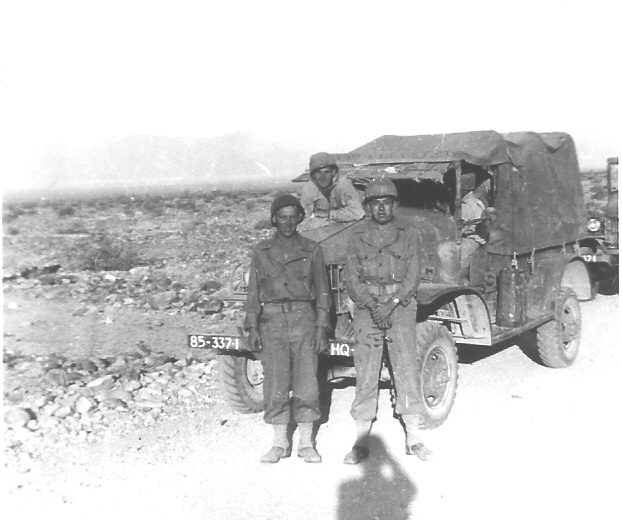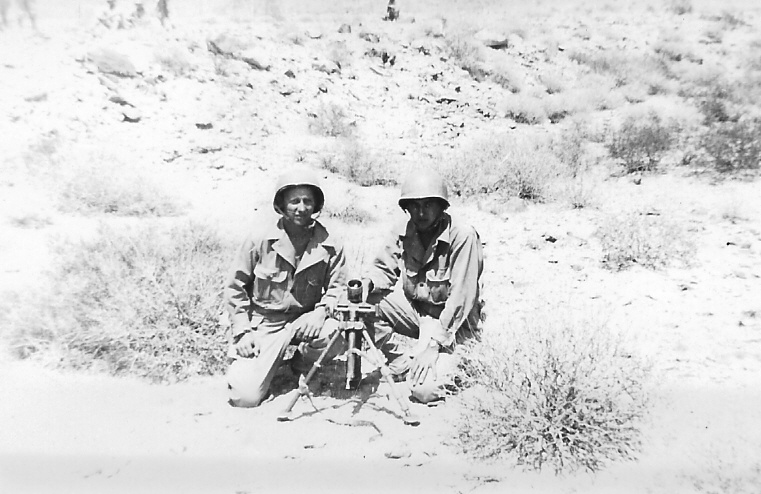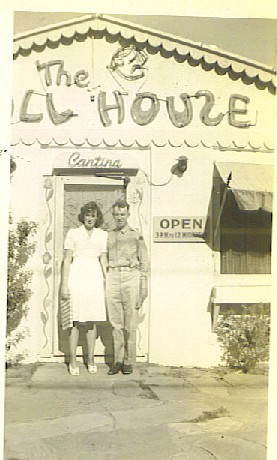| MENU SELECTION: | The Italian Campaign | At The Front | Books | Armies | Maps | 85th Division | GI Biographies | Websites |
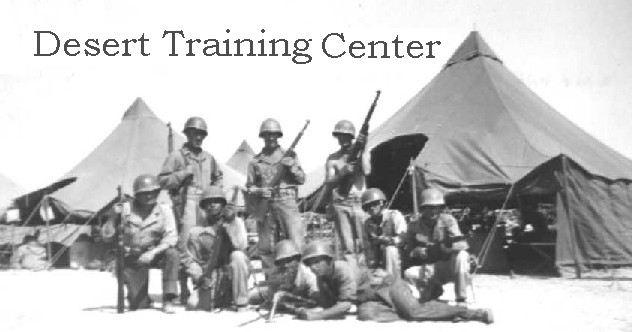
Desert
Training Center
or
California-Arizona
Maneuver Area
Training Camps in California used for Desert Warfare training.
Early
in June, 1943, the 85th Division moved to Camp Pilot Knob,
California,
where it began still more arduous training in the Desert Training
Center.
In August, the 85th moved to Camp Coxcomb, California where desert
training
was continued until October 1943. This was their last training before
they
were sent back across the country to Fort Dix and then on to Italy.
The Desert Training Center was used to train many divisions of
the
US Army in order to prepare them to fight the Germans in North African
desert. This page gives a brief history of the DTC, which was
later
renamed the California-Arizona Maneuver Area. I've tried to
provide
some details to describe the training and the hardships. Later, this
training
facility became a firing range of Yuma Proving Grounds. My
Dad never forgot his time at these Camps as he was involved in an
accident
that later affected his health. See his story below.
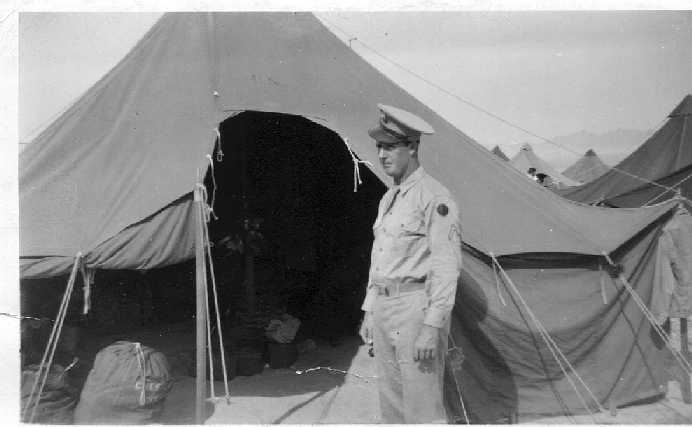
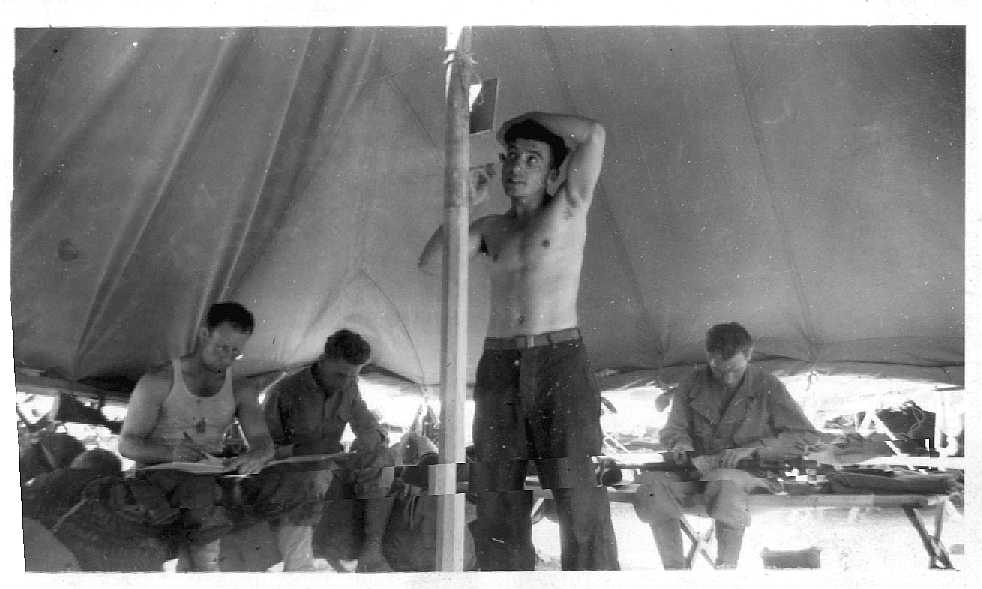
The above photos were taken of Private Lee
McCloud
and a few of his buddies of Company C, 310th Engineer Battalion.
For
more photos related to the 85th 'Custer' Division,
go to Photos
from 310th Engineer Battalion
or Photos
from the Italian Front.
Brief
History
of Desert Training Center
Reference: Army
Motors Magazine No. 40, dated 1987
Early in 1942, the War Plans Division of the War Department General Staff concluded that in order to prepare the American troops for fighting in the desert of North Africa, the Army would need an area for specially training and equipping troops for this type of combat. Also, the American armored fighting unit was in its infancy and new equipment was being added to this new type of service.
General HQ assigned General George S. Patton, Jr. as the commanding general of the 1st Armored Corps and asked him to locate a place in the desert southwest that would be suitable for the location of a training site. General Patton flew over the area of California and Arizona and finally decided on a site that could be supported by water supply and rail access. He made arrangements with the Metropolitan Water District to supply water for the site and set up advance parties that would prepare the facilities. The training for the 1st Armored Corps began on 20th April, 1942 and ended 6 weeks later.
During October 25 to November 13, 1943, the 15th Corps maneuvers were carried out in the Palen Pass area east of Camp Coxcomb. This included the 81st and the 79th Infantry Divisions, the 15th Mechanized Cavalry, 182nd and 119th Field Artillery Groups, 3rd Field Artillery Observation Battalion , 185th Tank Destroyer Battalion and 2 anti-aircraft groups.
After the German army surrendered in North Africa, there was no further need for a desert training facility. Just to ensure the camps would not be closed, the Desert Training Center was renamed on 20 October, 1943, as the California-Arizona Maneuver Area or CAMA.
The next big maneuver was carried out by the 4th Corps from November 20 to December 11, 1943. This exercise included the 90th and 93rd Infantry Divisions, 11th Cavalry Group, 22nd and 33rd Anti-aircraft Groups, 12th Tank Destroyer Group and the 711th Tank Battalion. The Air Force units for CAMA were reassigned to the command of the Third Air Force. Previously the support air units was in direct command of the ground forces.
With a lack of service units still available in the US, the camps could not be supported. On 21st January, 1944, the Arm Ground Forces HQ directed that maneuvers would be discontinued after April 15th. The last maneuvers was performed by the 10th Corps from February 15 to March 3 and involved 80th and 104th Infantry Divisions, 15th Tank Destroyer Group, two tank destroyer battalions and two anti-aircraft battalions.
On April 30th, 1944, the control of the CAMA was turned over to the Ninth Service Command for salvage and removal of equipment.
The DTC had several advantages for training for any sized unit. The spacious land provided room for cross-country navigation, recon, night operations, laying mine fields and anti-aircraft operations. However, there were many problems with the facilities. There was a chronic shortage of vehicles and parts to maintain them in this harsh environment. Maintenance had to be performed outdoors or in crude shelters. Some maintenance units did not get to participate in the field maneuvers. One exercise was delayed 13 weeks for due to lack of vehicle maintenance.
Another example of poor operations was the 9th Corps maneuvers was criticized for its lack of realism. Soldiers were encouraged to break for afternoon naps. One result was that orders were issued to restrict the menu to B-rations and the elimination of cold beer and ice cream. Despite the problems, the DTC was the most realistic training available to the US Ground Forces.
By May of 1944, the CAMA was closed, along with the Tennessee and the West Virginia maneuver areas. Only the Louisiana facility used by ground forces and the Carolina facility used by airborne forces remained operative. Salvage began in February using 1300 volunteer Italian prisoners of war captured in Tunisia in 1943. They were paid 80 cents per eight hours of labor, ate GI food, and wore GI uniforms with a small green “Italy” shoulder patch. Everything was salvaged, which explains why so few relics can be found on these sites today.Several of the sites are now off-limits to the public or are located on private property.
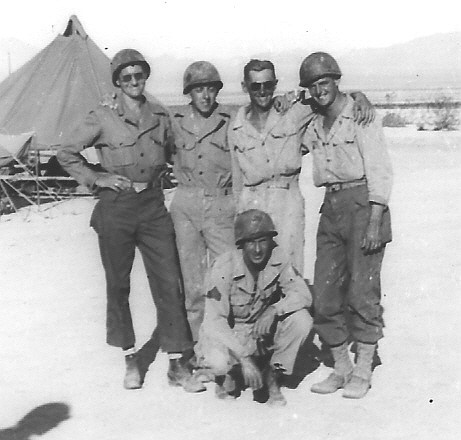 The tall soldier on the right is PFC Alfred Winsel. The 2nd soldier from the left is believed to be PFC John Callahan, first cousin of Winsel's wife. Interesting uniform details. The two in the center appear to be wearing a jump suite. The darker trousers have a cargo pocket on the hip; clear in the next photo. (Dion photo) |
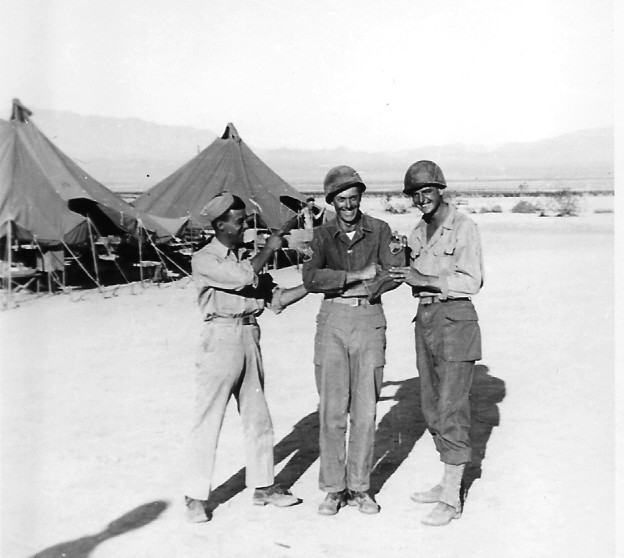 PFC Alfred Winsel (right) appears to be showing off the rank of a newly promoted Staff Sergeant. Another great view of the tents and the arid landscape. (Dion photo) |
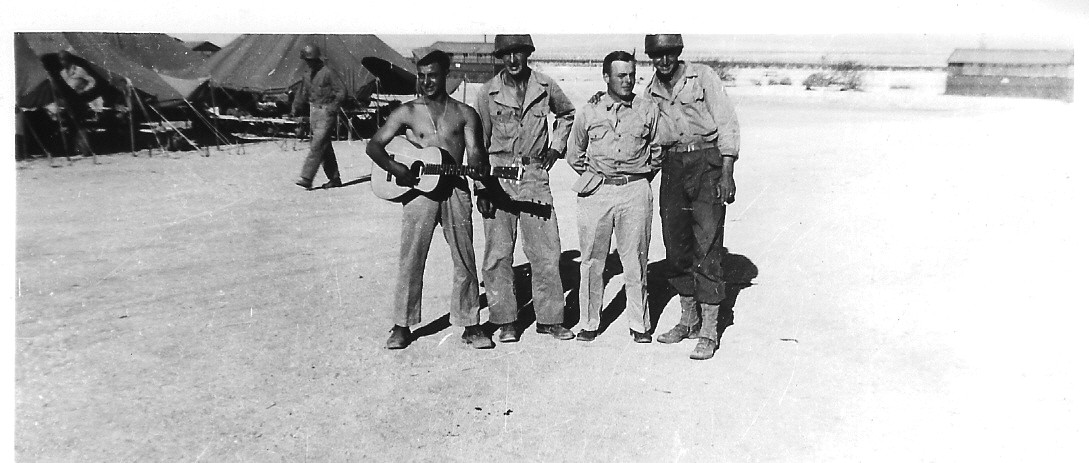 "Mojave Desert" - A great casual photo of the soldiers and the camp. The soldier on the right is PFC Alfred Winsel (later promoted to Sergeant). Note the one 'permanent building' in the background. Photo was cut off at the top. A good study of the variety of uniforms worn in the desert, from the nice tan shirt with tie to the heavy khaki trousers with gaiters. Also, I'm almost sure they are wearing only the light helmet liner in all of these casual photos. The steel 'pot' would have been unbearably hot. (Dion photo) |
Chow Time was usually the high-light of a soldier's day when he could expect to get a good hot meal. Photo from collection of Corp. Deyo Montanya of Company C, 310 Combat Engineering Battalion, donated by his daughter, Anita. |
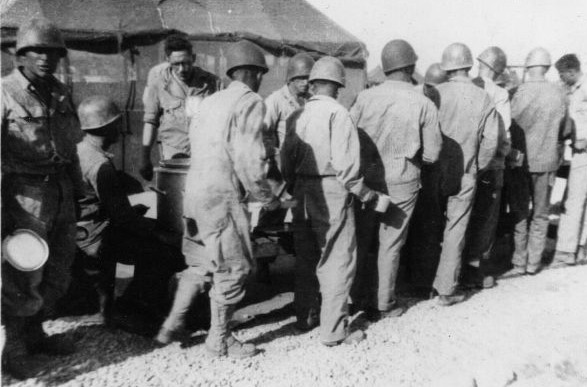 |
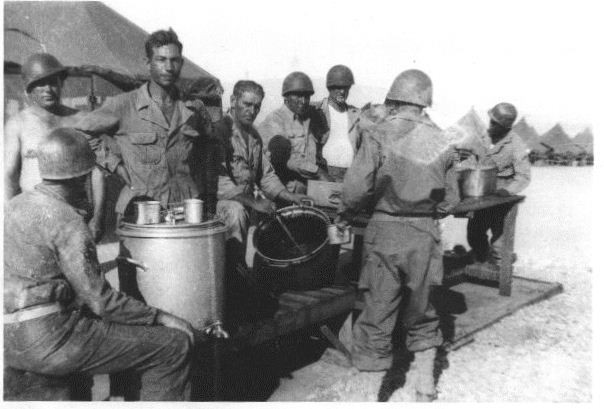 |
Map 1 shows a general area of the Desert
Training
Center that is in California near San Bernardino, Palm Springs and
Twenty-Nine
Palms. Click on Map 1 for a larger, more
detailed
map. Map 2 also shows location of Camps Bouse, Clipper,
Horn,
Hyder,
Ibis,
Iron
Mountain, Laguna, and Young. Return to this page
using
your "return" feature of your web browser.
Maps
of the Desert
Training Center located in southern California, near Yuma,
Arizona.
Scans from a 1943 Air Navigation Chart "San
Diego".
DTC Base
- Desert Training Center & Chocolate
Mtns.
Blythe AAF - East of above map: Army
Air Field & Colorado River.
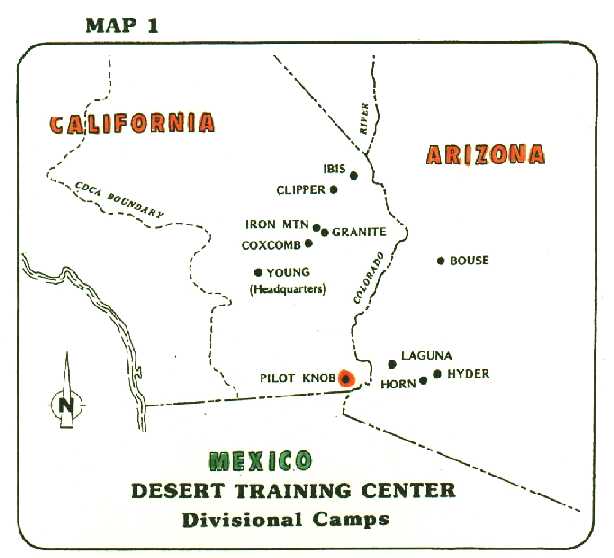
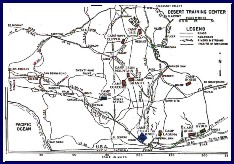
Click
Here or on above Map for a larger, more
detailed Map
with highways identified.
The 85th "Custer" Division at Desert Training Center
Reference: Paul Schultz's book "The 85th Division in WW2"In May of 1943, the 85th Division had completed training at Louisiana Maneuvers. They received orders to be prepared to move but they were to transfer all of their vehicles over to the 42nd Division at Camp Gruber, OK. As their trains took them towards the west coast, the speculation was that they would be embarking for the Pacific. Instead, they had been shipped to Imperial Valley in Southern California for desert warfare training.
Their first stay was at Camp Pilot Knob, 11 miles east of Yuma, AZ. Their living quarters were tents, the only shade around. Orders were issued for siesta each day between 1200 and 1400. Many troops simply poured water on their cots and stripped down for their siesta.
The Division began practicing at firing ranges for all types of weapons. The main emphasis was on development of the small unit. Even the 310th Engineers practiced infantry tactics and small-unit firing problems with live ammo. Platoon leadership courses were devised and the 40-men unit went on 6-day problems to teach leadership, as well as how to cope with the harsh desert environment.
During a platoon leadership course on 24-25 July, one company of the 337th Regiment became loss northwest of base camp. On the first night of the 6-day problem, the platoon became separated from its food and water supply. The next morning, Lt. Sanford L. Miller, with the platoon guide, Pvt. William C. Day, set out for base camp for were and were successful in finding their way back to Pilot Knob. During their absence, Pvt. James H. Nash died from exposure. Sgt. Robert J. Powers and Cpl. Julius Ortega, believing that Lt. Miller and Private Day had become lost, also left the platoon in search of food and water. In the meantime, Pvt. William P. Kisner, of the Medical Detachment became separated from the platoon and was reported missing. Relief finally came. For several days, the entire 337th Regiment spread out single file over the large area and searched for their comrades. Finally Ortega and Powers were found---dead. Kisner remained missing.
San Diego was 127 miles away. The soldiers used their weekend passes to go to Yuma, AZ, and Holtville and El Centro, CA. Some were able to make trips outside the US to Calexico and Mexicali.
On 1 August, 1943 they received orders to move to a new desert camp about 50 miles from Camp Young, to Camp Coxcomb. This camp was about the same except the PXs had wooden floors and screens, although the roof was tent canvas and the latrines were more elaborate with wooden floors and screens. During this time, the War Department activated cannon companies as an integral part of each regiment.
On 20 August, the Division was treated to a tremendous fire power demonstration of aircraft and infantry. The demo included P-38 fighters that attacked ground targets. Then the entire 2nd Battalion of the 339th Regiment massed along the firing line and fired all the weapons at once, including rifles, machine guns and mortars.
During their stay in the desert, they saw many sand twisters. But on two occasions they were caught in a freak desert rain and wind storm. These appeared in less than 20 minutes. One of these lasted an hour and left one man dead from a lightning strike and 300 tents destroyed.
Desert field exercises were carried out by battalion and involved a meeting engagement with the enemy, an overnight bivouac and an early morning attack. These were held across the valley from the base camp just before the Palen Pass, which ran between the Little Maria and Palen Mountains. Then in mid-September, their maneuvers were suddenly cut short by orders from the War Department. Soon they would be boarding a train for a long journey across the entire US to Fort Dix, NJ.
The 85th Division became the first US division to complete desert training during the hot months of June, July & August.
Jeep Wreck at Yuma
as told by Sgt. N. F. ColeAfter basic training in Camp Shelby, MS and field maneuvers in Louisana, the 85th Division went to Yuma, CA for desert warfare training. The Allies at this time were still fighting Rommel in the deserts of North Africa. As part of the exercise, the 328th Field Artillery was moving in a convoy through the desert. During a long drive, the convoy was required to pull off to the side of the road and rest for 10 minutes during each hour of the drive. The 328th Field Artillery used Jeeps but they hauled most of their equipment in open command cars(which Sgt. Cole sometimes referred to as a Jeep).
So when the time for the rest stop came, Sgt Cole's section parked their radio-equiped command car off the road and waited. The lead driver was watching his watch for the end of the rest period. He called out "One minute to go. " Then, "45 seconds…..30 seconds…..10 seconds". Then comes the command, "Pull out!".
About that time, a vehicle from another unit was trying to take advantage of the cleared road and was barreling down the desert road past the parked convoy. When the command was given to "Pull Out", Sgt. Cole's car pulled in front of this on-coming vehicle. Wham!
After the dust settled, they found Sgt. Cole lying in the sand. He was dazed and kept asking "Where is my .45 (pistol)?" When he came to his senses, he was in a hospital bed. Sgt. Cole never liked hospitals, so he got out of bed, dressed and told the nurse he was leaving. She protested-- but to no avail. Sgt. Cole proceeded to the clerk's desk to get the necessary discharge papers. At the front office, he recognized the volunteer clerk at the desk as none other than Robert Mitchum, the actor. (That is according to Dad. Then again, remember, he just recovered from a bump on his head.)Many years later, my Dad experienced a slipped disc and back trouble and had to lay in traction for weeks. Doctors attributed his back problems to his accident he had in 1943---a 'souvenir' of Camp Pilot Knob.
Some men from Company 'I', 337th Regiment, in what appears
to be a convoy, as described in the above article.
The soldier on the right is believed to be John Callahan, a relative of Sgt. Wensel.
(Dion photo)
Photo of a mortar team ready for action. Obviously this is a hot sunny day.
This is the only photo I've seen of soldiers in actual combat training at the DTC.
The sun probably caused the photo to be over-exposed. (Dion photo)
The Doll House
Palm Springs, CA - 1943The soldiers found relief from the heat during while on leave to the southern California towns.
Many wives followed their husbands to their training bases or visited them. This was true at other Army bases. My mother made a cross-country trip by train with an infant to visit my Dad at Yuma.
I hope to interview another lady about the details of her trip and stay.
(Photo courtesy of Bill Dempsey)
A special Thanks to Mr. Francis Blake and his articles in Army Motors . He contacted me after locating my skimpy webpage on the DTC and offered to send me copies of his articles and several maps of the locations of the camps. His articles were very informative and has some great photos take during the WW2 training and some taken of relics that were left in the desert.
A special thanks to Susan Dion of Massachusetts for sharing the photos of her father, Sgt. Alfred Winsel of Company I, 337th Infantry Regiment, 85th Division. She has given permission to use some of her Dad's photos, which provide a great view of the soldier's training in the hot desert.
Return to History of 85th Division- detailed history of 85th Division.
Return to 85th Division Menu– Main Menu of 85th Division.
See also Camp Shelby training facility.
Check
out Site
Map for outline of entire website.
